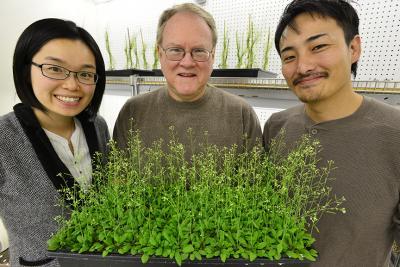COLUMBIA, Mo. – ATP (adenosine triphosphate) is the main energy source inside a cell and is considered to be the high energy molecule that drives all life processes in animals and humans. Outside the cell, membrane receptors that attract ATP drive muscle control, neurotransmission, inflammation and development. Now, researchers at the University of Missouri have found the same receptor in plants and believe it to be a vital component in the way plants respond to dangers, including pests, environmental changes and plant wounds. This discovery could lead to herbicides, fertilizers and insect repellants that naturally work with plants to make them stronger.
"Plants don't have ears to hear, fingers to feel or eyes to see," said Gary Stacey an investigator in the MU Bond Life Sciences Center and professor of plant sciences in the College of Agriculture, Food and Natural Resources. "Plants use these chemical signals to determine if they are being preyed upon or if an environmental change is occurring that could be detrimental to the plant. We have evidence that when ATP is outside of the cell it is probably a central signal that controls the plant's ability to respond to a whole variety of stresses."

Stacey and fellow researchers found the adenosine triphosphate receptor in plants believed to be a vital component in the way plants respond to dangers, including pests, environmental changes and plant wounds.
(Photo Credit: Photo courtesy of the University of Missouri News Bureau)
Stacey and fellow researchers, graduate student Jeongmin Choi and postdoctoral fellow Kiwamu Tanaka, screened 50,000 plants over two years to identify the ATP receptors. By isolating a key gene in the remaining plants, scientists found the receptor that aids in plant development and helps repair a plant during major events.
"We believe that when a plant is wounded, ATP is released into the wound and triggers the gene expressions necessary for repair," Stacey said. "We think ATP is central to this kind of wound response and probably plays a role in development and a whole host of other plant responses to environmental changes and pests. We believe that with further study, researchers may be able to identify ways to naturally work with a plant's own processes to protect it from major environmental events, plant wounds and insects."
Future research will focus on how this receptor works with ATP, its protein structure, how it reacts to pests and how it may signal growth.

Jeongmin Choi (left), Gary Stacey (center) and postdoc Kiwamu Tanaka recently discovered the first plant receptor for extracellular ATP.
(Photo Credit: Roger Meissen/Bond Life Sciences Center at MU)
Source: University of Missouri-Columbia